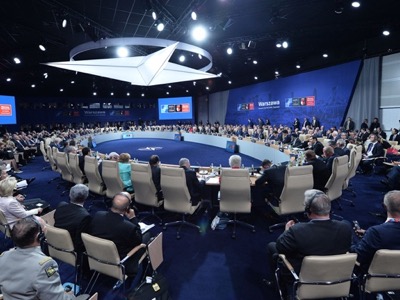
“Faced with the unprecedented challenges from the East and the South, the time has come to give a fresh impetus and new meaning to the Nato-EU partnership”: so commences the Joint Declaration signed on 8 July [2016] at the Nato Summit at Warsaw, by the Nato Secretary General (Jens Stoltenberg), the President of the European Council (Donald Tusk) and the President of the European Commission, (Jean-Claude Juncker) [1]
.
The EU representatives have placed a blank cheque in hands of the United States. In fact, the US controls Nato – to which 22 of the 28 EU countries belong (21 of 27 once Great Britain has left the EU) – and stamps it with the US strategy. Stated fully in the communication approved on 9 July by the Summit: a document of 139 points – agreed by Washington almost exclusively with Berlin, Paris and London – that the other Heads of State and governments, including Prime Minister Renzi, have signed with their eyes closed [2].
After having extended aggressively to the East penetrating within the territory of the former USSR, and having organized a neo-nazi putsch in Maidan Square to reopen the Eastern front against Russia, Nato accuses Russia of:
“aggressive actions, destabilizing Ukraine and violating human rights in Crimea, provocative military activities at the Nato borders in the Baltic and the Black Sea and in the East Mediterranean to sustain the regime in Syria, having manifested its intention to threaten and use force to obtain political ends, aggressive nuclear rhetoric”.
In response to all this, Nato “responds” by strengthening “the deterrence” (that is its nuclear forces in Europe) and its “advanced presence in the Eastern part of the Alliance” (that is the military line up coming up to Russia). This is a true and clear declaration of war (even if Nato assures that “it is not seeking confrontation with Russia”). This can blow up, at any time, any economic agreement between European Countries and Russia.
On the Southern front, after devastating Libya with a combination of internal and external action, and having tried the same operation in Syria (a failure on account of Russian intervention); after arming and equipping terrorist groups and promoting the formation of Isis/Daesh and its offensive in Syria and Iraq, rejecting the undulation of refugees to Europe, Nato declares that it is “concerned” by the crisis that threatens regional stability and the safety of its southern borders, due to the refugee’s humanitarian tragedy; it “condemns” the violence used by Isis/Daesh against civilians and, in the strongest terms, the Syrian regime and its supporters for violating the cease fire”.
To “respond to these threats, including those from the South”, Nato empowers its forces to high capacity and deployability. That requires “appropriate investment” that is adequate military expenditure that the allies have undertaken to increase.
According to official figures published by Nato during the Summit, it emerges that in 2015, Italy’s military expenditure was 17 billion 642 million Euro and the forecast for 2016 is estimated at 19 billion 980 million Euro, which represents an increase of 2.3 billion. Taking into account the “extra budgetary” military expenditure on Defense, (international missions, war ships and others), the actual costs is far higher. Going by the figures of Nato alone, in 2016 Italy spends on average around 55 million euro everyday on the military.
While Prime Minister Renzi struts about among the “big boys” at the Warsaw Summit, and Parliament (opposition included) looks the other way, Nato and the EU determine our life.
[1] « Déclaration commune OTAN-UE », par Donald Tusk, Jean-Claude Juncker, Jens Stoltenberg, Réseau Voltaire, 8 juillet 2016.
[2] “NATO Warsaw Summit Communiqué”, Voltaire Network, 9 July 2016.

 Articles by this author
Articles by this author Send a message
Send a message

















Stay In Touch
Follow us on social networks
Subscribe to weekly newsletter